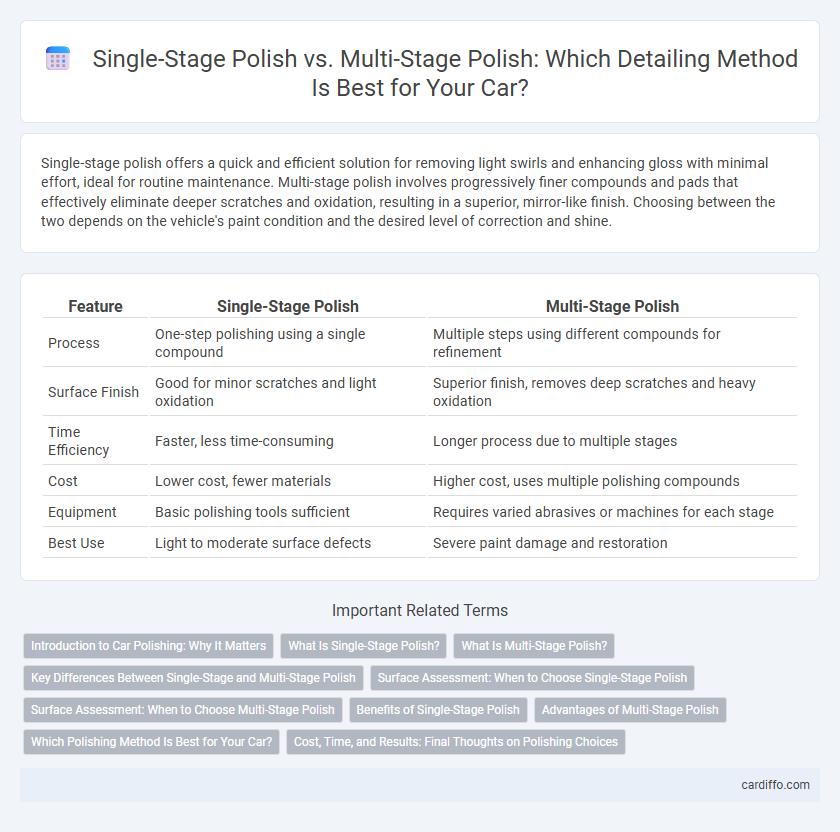Single-stage polish offers a quick and efficient solution for removing light swirls and enhancing gloss with minimal effort, ideal for routine maintenance. Multi-stage polish involves progressively finer compounds and pads that effectively eliminate deeper scratches and oxidation, resulting in a superior, mirror-like finish. Choosing between the two depends on the vehicle's paint condition and the desired level of correction and shine.
Table of Comparison
| Feature | Single-Stage Polish | Multi-Stage Polish |
|---|---|---|
| Process | One-step polishing using a single compound | Multiple steps using different compounds for refinement |
| Surface Finish | Good for minor scratches and light oxidation | Superior finish, removes deep scratches and heavy oxidation |
| Time Efficiency | Faster, less time-consuming | Longer process due to multiple stages |
| Cost | Lower cost, fewer materials | Higher cost, uses multiple polishing compounds |
| Equipment | Basic polishing tools sufficient | Requires varied abrasives or machines for each stage |
| Best Use | Light to moderate surface defects | Severe paint damage and restoration |
Introduction to Car Polishing: Why It Matters
Single-stage polish delivers quick surface correction by removing minor scratches and enhancing gloss, ideal for light to moderate paint imperfections. Multi-stage polish involves progressively finer compounds and pads to restore deep scratches, oxidation, and severe swirl marks, achieving a flawless finish on automotive paint. Proper car polishing not only boosts aesthetic appeal but also protects and extends the lifespan of the vehicle's clear coat.
What Is Single-Stage Polish?
Single-stage polish involves using one compound and one polishing step to remove scratches and restore gloss on a vehicle's paint surface. This method is ideal for lightly oxidized or mildly scratched finishes, offering a quicker process with less product and effort. Single-stage polish maintains more of the clear coat while enhancing shine, making it suitable for routine maintenance or lightly damaged paint.
What Is Multi-Stage Polish?
Multi-stage polish involves a systematic process using several types of polishing compounds and pads to achieve a flawless surface finish. This technique targets different levels of paint correction, starting with heavy defect removal and progressing to fine polishing for enhanced gloss and clarity. By combining multiple stages, multi-stage polish delivers superior depth and durability compared to single-stage polishing.
Key Differences Between Single-Stage and Multi-Stage Polish
Single-stage polish involves applying a single abrasive compound to restore paintwork quickly, ideal for minor imperfections and light scratches. Multi-stage polish incorporates a sequence of abrasive compounds and pads to progressively remove deeper scratches, oxidation, and swirl marks, achieving a superior finish on heavily damaged surfaces. The key difference lies in the depth of correction and finish quality, with multi-stage polish offering a more thorough and refined result for automotive detailing.
Surface Assessment: When to Choose Single-Stage Polish
Single-stage polish effectively restores light to moderate surface imperfections on paint, providing a smooth and glossy finish without aggressive abrasion. It is ideal for vehicles with minimal swirl marks or oxidation where maintaining clear coat thickness is crucial. Opt for single-stage polish when the surface assessment shows shallow defects that do not require extensive compounding.
Surface Assessment: When to Choose Multi-Stage Polish
Multi-stage polish is essential for vehicles with deep scratches, oxidation, or severe paint imperfections, as it allows progressive correction through varied abrasive levels, ensuring a flawless finish. Surface assessment should prioritize clear signs of damage and paint thickness, making multi-stage polish ideal for maintaining paint integrity while achieving superior clarity. For lightly swirled or mildly weathered surfaces, single-stage polish suffices, but complex defects demand the controlled refinement of multi-stage methods.
Benefits of Single-Stage Polish
Single-stage polish offers significant time savings by combining correction and finishing in one step, making it ideal for routine maintenance and light swirl removal. This method reduces the need for multiple products and equipment, lowering overall detailing costs and simplifying the process for both professionals and enthusiasts. Enhanced efficiency and minimized labor efforts make single-stage polish a practical choice for maintaining vehicle paint with consistent, high-gloss results.
Advantages of Multi-Stage Polish
Multi-stage polish provides superior paint correction by using a sequence of compounds and polishes that progressively remove deeper imperfections and finer swirls, resulting in a flawless, glass-like finish. This method enhances surface clarity and maintains paint gloss while minimizing the risk of introducing new scratches or holograms. Professional detailers prefer multi-stage polish for its ability to restore heavily damaged or aged automotive paint with long-lasting, showroom-quality results.
Which Polishing Method Is Best for Your Car?
Single-stage polish provides a quicker and more cost-effective solution for light paint correction and minor swirl removal, ideal for well-maintained vehicles. Multi-stage polish involves a combination of compounding, polishing, and finishing steps, delivering deeper correction by effectively removing severe scratches, oxidation, and surface imperfections. Choosing the best polishing method depends on your car's paint condition, desired level of correction, and long-term maintenance goals.
Cost, Time, and Results: Final Thoughts on Polishing Choices
Single-stage polish offers a cost-effective and time-efficient solution for light to moderate paint correction, delivering satisfactory results with minimal effort. Multi-stage polish requires a higher investment in both time and money but achieves superior depth, clarity, and long-lasting protection, ideal for severe imperfections and show-quality finishes. Choosing between the two depends on budget constraints, desired finish quality, and available time for detailing.
Single-Stage Polish vs Multi-Stage Polish Infographic

 cardiffo.com
cardiffo.com